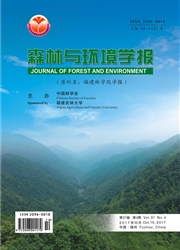

 中文摘要:
中文摘要:
构树是喀斯特地区的先锋树种之一,文中分析了喀斯特地区不同干扰条件下构树萌枝种群的数量特征、年龄结构及空间分布格局。结果表明,不同干扰条件下的构树萌枝种群年龄结构呈现增长、稳定和衰退的趋势;萌枝种群结构可分为5种主要类型,各类型的数量和年龄结构与干扰有关,说明萌枝是主要的更新方式,干扰是影响萌枝产生的主要因素,中度干扰促进了构树萌枝的发展。萌枝种群的空间分布格局分析表明乔木层呈随机分布型,而灌木层呈集群分布型,主要与构树本身的生物学和生态学特性密切相关,同时受干扰及群落内生境异质性的影响。
 英文摘要:
英文摘要:
Broussonetia papyrifera was one of pioneer tree species in karst region. The quantitative characteristics, the age structure and the spatial distribution patterns of B. papyrifera sprouting population were analyzed in different disturbance conditions of karst region. The results were as follows : The age structure of B. papyrifera sprouting population showed three kinds of trends of growth, stability and decline under the different interference; The structure of sprouting population could be divided into 5 main types, number and age structure of each type were related with disturbance, which indicated that the sprouting was the main regenerated approach of B. papyrifera and disturbance was the main factor that influenced the sprouting producing . Moreover, the disturbance of medial level by human being might enhance the development of B. papyrifera sprouting. The spatial distribution patterns of B. papyrifera sprouting population showed that the arboreal individuals performed the pattern of random distribution, while the shrubby individuals clumped, which closely related to its ecological and biological characteristics, as well as been affected by disturbance and habitat heterogeneities.
 同期刊论文项目
同期刊论文项目
 同项目期刊论文
同项目期刊论文
 Dynamics of a stage-structured predator-prey model with prey impulsively diffusing between two patch
Dynamics of a stage-structured predator-prey model with prey impulsively diffusing between two patch Dynamical analysis on a single population model with state-dependedt impulsively unilateral diffusio
Dynamical analysis on a single population model with state-dependedt impulsively unilateral diffusio Dynamical analysis of a five-dimensioned chemostat model with impulsive diffusion and pulse input en
Dynamical analysis of a five-dimensioned chemostat model with impulsive diffusion and pulse input en DYNAMICAL ANALYSIS OF A THREE-DIMENSIONAL PREDATOR-PREY MODEL WITH IMPULSIVE HARVESTING AND DIFFUSIO
DYNAMICAL ANALYSIS OF A THREE-DIMENSIONAL PREDATOR-PREY MODEL WITH IMPULSIVE HARVESTING AND DIFFUSIO Analysis of a delayed predator-prey system with birth pulse and impulsive harvesting at different mo
Analysis of a delayed predator-prey system with birth pulse and impulsive harvesting at different mo Analysis of a stage-structured predator-prey system with birth pulse and impulsive harvesting at dif
Analysis of a stage-structured predator-prey system with birth pulse and impulsive harvesting at dif Dynamical analysis of a biological resource management model with impulsive releasing and harvesting
Dynamical analysis of a biological resource management model with impulsive releasing and harvesting 期刊信息
期刊信息
